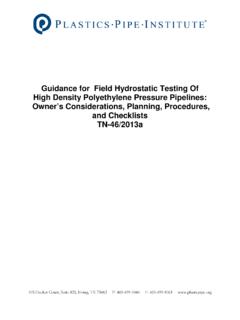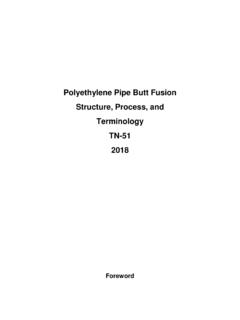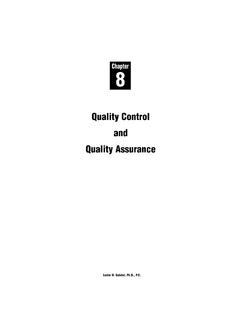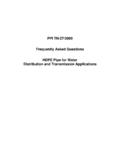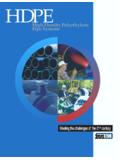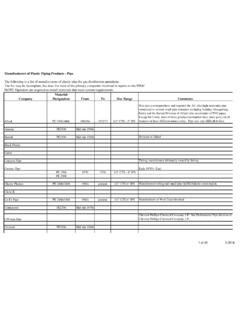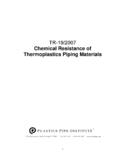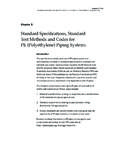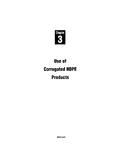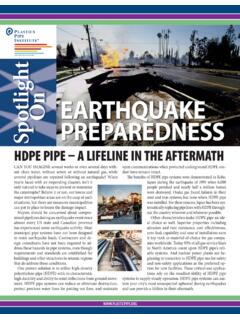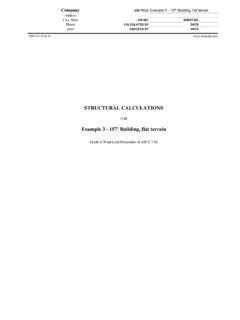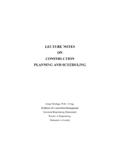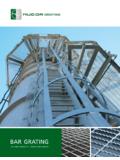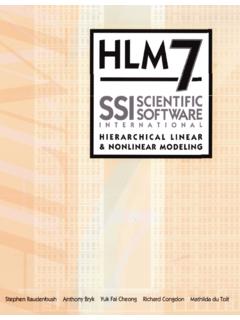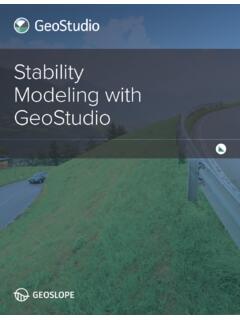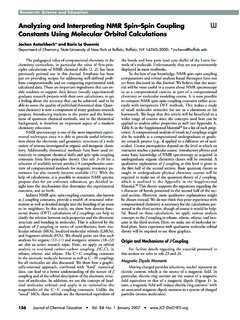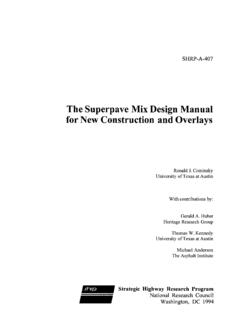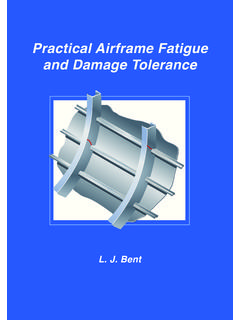Transcription of Handbook of PE Pipe Table of Contents
1 Table of ContentsiiiContentsForeword The Plastics Pipe Institute Handbook of Polyethylene PipeChapter 1 Introduction 5 Features and Benefits of PE Pipe 6 References 13 Chapter 2 Inspections, Tests and Safety ConsiderationsIntroduction 15PE Piping in the Field 16 Packaging for Commercial Transport 16 Receiving Inspection 18 Checking and Inspecting the Order 19 Receiving Report & Reporting Damage 19 Field Handling 20 Handling Equipment 21 Unloading Site 22 Unloading Bulk Packaged Pipe, Fittings and Fabrications 22 Unloading Large Fabrications, Manholes and Tanks 22 Pre-Installation Storage 22 Pipe Stacking Heights 23 Exposure to UV and Weather 24 Cold Weather Handling 25 General Considerations Before and During Installation 25 Pre-Construction 25 Joining and Connections 25 Cleaning Before Joining 27 Field Fusion Joining 27 During Construction and Installation 28 Damage Inspections 28 Butt Fusion Joint Quality 28 Soil Tests 29 Deflection Tests for ID controlled Pipes 30 Post Installation 32 Leak Testing Considerations for All Procedures 32 Pressure System Leak Testing Hydrostatic 34 Pressure System Leak Testing Pneumatic 35 Pressure System Leak Testing Initial Service 36 Non-Pressure System Leak
2 Testing 37 Non-Testable Systems 37 Considerations for Post Start-Up and Operation 37 Disinfecting Water Mains 31/16/09 9:38:34 AMTable of ContentsivCleaning 38 Squeeze-Off 38 References 41 Chapter 3 Material Properties Introduction 43PE Plastics 45 History of PE 46 Manufacture of PE 46 Polymer Characteristics 47 Density 47 Crystallinity 48 Molecular Weight 50 Effect of Molecular Weight Distribution on Properties 53PE Piping Materials 55 Structural Properties 56PE Pipe Material Designation Code Identifies the Standard Classification of Essential Properties 56 Stress/Strain Response and its Representation by Means of an Apparent Modulus 57 Apparent Modulus Under Compressive Stress 63 Stress/Fracture Behavior and the Determination of Working Strength 64 Establishing a PE s Long-Term
3 Hydrostatic Strength (LTHS) and its Derivative, The Hydrostatic Design Basis (HDB) 66 Compensating for the Effect of Temperature on Working Strength 72 Compressive Strength 73 Evaluating the Resistance to Slow Crack Growth (SCG) of a Sharply Notched PE Specimen 73 Resistance to Pressure Surges 74 Reaction to Occasional Pressure Surges 75 Reaction to Frequently Occurring Pressure Surges 75 Other Engineering Properties 76 Mechanical Properties 76 Resistance to Rapid Crack Propagation 79 Abrasion Resistance 79 Thermal Properties 80 Coefficient of Expansion/Contraction 80 Thermal Conductivity 81 Specific Heat 81 Material Classification Properties 81 Density 41/16/09 9:38.
4 34 AMTable of ContentsvMelt Index 82 Flexural Modulus 83 Tensile Strength at Yield 83 Color and UV Stabilization 84 Electrical Properties 85 Static Charge 85 Chemical Resistance 85 Permeability 88 Properties Related to Durability 90 Weatherability 90 Stabilization 90 Biological Resistance 91 Properties Related to Health and Safety Concerns 92 Toxicological 92 Health Effects 92 Flammability 92 Combustion Toxicity 93 References 93 Appendix A: Pipe Pressure Rating (PR) And Pressure Class (PC) 95 Appendix B: Apparent Elastic Modulus 99 Appendix C: Allowable Compressive Stress 102 Appendix D: Poisson s Ratio 102 Appendix E: Thermal Properties 103 Appendix F: Electrical Properties 103 Chapter 4 PE Pipe and Fittings ManufacturingIntroduction 105 Raw Materials Description 106 Extrusion Line 107 Raw Materials Handling 107 Extrusion Basics 108 Extruders 110 Breaker Plate/Screen Pack 110 Die Design 110 Pipe Sizing 112 Cooling 114 Pullers 114 Take-off Equipment 114 Saw Equipment and Bundling 115 Injection Molded Fittings 115 Fabricated Fittings 118 Thermoformed Fittings 119 Electrofusion Couplings 119 Injection Molded Couplings 51/16/09 9:38.
5 34 AMTable of ContentsviQuality Control/Quality Assurance Testing 121 Workmanship, Finish, and Appearance 121 Dimensions 122 Physical Property Tests 122 Quality Assurance Summary 123 References 123 Chapter 5 Standard Specifications, Standard Test Methods and Codes for PE (Polyethylene) Piping SystemsIntroduction 125 Standard Requirements for PE Piping Materials 126 Standard PE Piping Material Designation Code 129 Standard Equation for Determining the Major Stress Induced in a Pressurized Pipe 130 Standard Diameters 132PE Pipe Standards are Simplified by the Use of Preferred Values 132 Determining a PE s Appropriate Hydrostatic Design Stress (HDS) Category 134 Determining the Appropriate Value of HDS 135A Widely Recognized Source of HDS Recommendations 138 Standard Specifications for Fittings and Joints 139 General 140 Codes, Standards and Recommended Practices for PE Piping Systems 141 Plastics Pipe Institute ( PPI)
6 141 ISO 143 NSF International 143 AWWA 144 Standard Plumbing Codes 145 Other Codes and Standards 146 Factory Mutual 146 References 147 Appendix 1 148 Gas Pipe, Tubing and Fittings 150 Installation 152 Chapter 6 Design of PE Piping Systems Introduction 155 Section 1 Design Based on Required Pressure Capacity 157 Pressure Rating 157 Pressure Rating for Fuel Gas Pipe 160 Pressure Rating for Liquid Flow Surge Pressure 161 Controlling Surge Pressure Reactions 61/16/09 9:38:34 AMTable of ContentsviiSection 2 Hydraulic Design of PE Pipe 168 Pipe ID for Flow Calculations 168 Flow Diameter for Outside Diameter Controlled Pipe 168 Pipe Diameter for ID Controlled Pipe 169 Fluid Flow in PE Piping 169 Head Loss in Pipes Darcy-Weisbach/Colebrook/Moody 169 Pipe Deflection Effects 172 Head Loss in Fittings 173 Head Loss Due to Elevation Change 174 Pressure Flow of Water Hazen-Williams Equation 175 Pipe Flow Design Example 176 Pressure Flow of Liquid Slurries 177 Particle Size 177 Solids Concentration and Specific Gravity 178 Critical Velocity 178 Compressible Gas Flow 182 Empirical Equations for Low Pressure Gas Flow 183 Gas Permeation
7 184 Gravity Flow of Liquids 185 Manning Flow Equation 186 Comparative Flows for Slipliners 188 Flow Velocity 189 Pipe Surface Condition, Aging 190 Section 3 Buried PE Pipe Design 191 Calculations 192 Installation Categories 193 Design Process 194 Earth, Live, and Surcharge Loads on Buried Pipe 195 Vertical Soil Pressure 195 Earth Load 196 Live Load 197 AASHTO Vehicular Loading 198 Impact Factor 199 Vehicle Loading through Highway Pavement (Rigid) 199 Railroad Loads 204 Surcharge Load 205 Installation Category 1: Standard Installation - Trench or Embankment 210 Pipe Reaction to Earth, Live, and Surcharge Loads 210 Ring Deflection 210 Apparent Modulus of Elasticity for Pipe Material, E 212 Ring Stiffness Constant, RSC 212 Modulus of Soil Reaction, E 213 Soil Support Factor, FS 215 Lag Factor and Long-Term Deflection 71/16/09 9:38:34 AMTable of ContentsviiiVertical Deflection Example 217 Deflection Limits 217 Compressive Ring Thrust 219 Allowable Compressive Stress 220 Ring Compression Example 220 Constrained (Buried) Pipe Wall Buckling 220 Luscher Equation for Constrained Buckling Below Ground Water Level 221 Constrained Buckling Example 223 Installation Category #2.
8 Shallow Cover Vehicular Loading 224 Shallow Cover Example 225 Installation Category #3: Deep Fill Installation 226 Compressive Ring Thrust and the Vertical Arching Factor 227 Earth Pressure Example 228 Ring Deflection of Pipes Using Watkins-Gaube Graph 229 Example of the Application of the Watkins-Gaube Calculation Technique 232 Moore-Selig Equation for Constrained Buckling in Dry Ground 232 Critical Buckling Example 233 Installation Category #4: Shallow Cover Flotation Effects 233 Design Considerations for Ground Water Flotation 234 Unconstrained Pipe Wall Buckling (Hydrostatic Buckling) 238 Ground Water Flotation Example 240 Section 4 Thermal Design Considerations 242 Strength and Stress/Strain Behavior 242 Thermal Expansion/Contraction Effects 243 Unrestrained Thermal Effects 243 End Restrained Thermal Effects 244 Above Ground Piping Systems 245 Buried Piping Systems 245 Appendix 249 Appendix 253 Appendix 261 Chapter 7 Underground Installation of PE Piping Introduction 265 Flexible Pipe Installation Theory 266 Terminology of Pipe Embedment Materials 266 Engineered and Simplified Installation Guidelines for PE Pipe 268 Simplified Installation Guidelines for Pressure Pipe 268 Simplfied Step-by-Step Installation 269 Trenching 269De-watering 269
9 Bedding 81/16/09 9:38:34 AMTable of ContentsixPlacing Pipe in Trench 270 Pipe Embedment 270 Leak Testing 270 Trench Backfill 270 Engineered Installation Guidelines for PE Pipe 271 Deflection Control 271 Deflection Limit 273 Pipe Embedment Materials 273 Classification and Supporting Strength of Pipe Embedment Materials 274 Strength of Embedment Soil 274 Embedment Classification Per ASTM D-2321 274 Class I and Class II 274 Migration 275 Cement Stabilized Sand 276 Class lIl and Class IVA 277 Class IVB and Class V 277 Compaction of Embedment Materials 277 Density Requirements 277 Compaction Techniques 278 Compaction of Class I and II Materials 279 Compaction of Class lIl and IV Materials 280
10 Density Checks 280 Trench Construction 280 Trench Width 281 Trench Length 282 Stability of the Trench 282 Stability of Trench Floor 283 Stability of Trench Walls 284 Portable Trench Shield 285 Installation Procedure Guidelines 286 Trench Floor Preparation 287 Backfilling and Compaction 289 Backfill Placement 289 Sunlight Exposure 291 Cold (Field) Bending 291 Installation of Pipe in Curves 292 Transition from PE Pressure Pipe to Gasket Jointed Pipe 292 Proper Burial of Fabricated PE Fittings 293 Inspection 295 References 295 Appendix 1 296 Appendix 2 296 Appendix 3 91/16/09 9:38:34 AMTable of ContentsxChapter 8 Above-Ground Applications for PE Pipe Introduction 305 Design Criteria 306 Temperature 306 Pressure Capability 307 Low Temperature Extremes 307 Expansion and Contraction 308 Chemical Exposure 308 Ultraviolet Exposure 309 Mechanical Impact or Loading 309 Design Methodology 310 Pressure Capability 310 Expansion and Contraction 311 Installation Characteristics 314On-Grade Installations 314 Free Movement 315 Restrai
